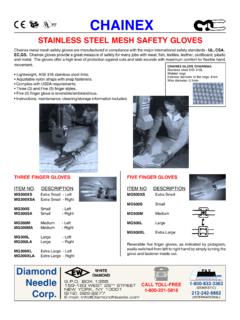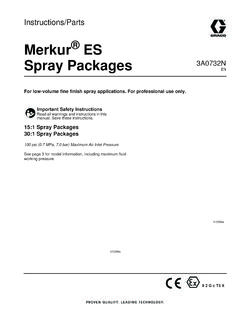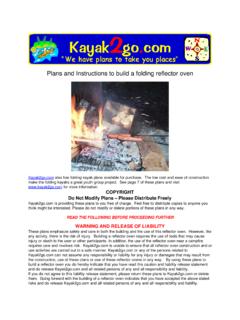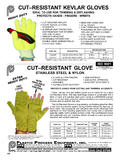Transcription of DRIED FRUIT - Food and Agriculture Organization
1 DRIED FRUIT . Food and Agriculture Organization of the United Nations DRIED FRUIT . General information DRIED FRUIT - general information Drying is one of the oldest methods of food preservation. It is still used widely to preserve foods for home consumption and for sale. DRIED fruits are one of the most popular products made by small-scale processors. Drying removes the water from foods so that the growth of micro-organisms is inhibited. It also reduces the weight and bulk of foods which cuts down on transport and storage costs. Sun drying is the simplest and cheapest method of drying. It is used for high volume foods such as grain, rice, sultanas and raisins. The disadvantage of sun drying is that the processor has very little control over the drying conditions and the quality of the DRIED FRUIT . There are two main forms of DRIED FRUIT - semi-moist and DRIED fruits. Semi-moist fruits, such as grapes contain naturally high levels of sugar which means they can be preserved with a higher moisture content than most other DRIED fruits.
2 Semi-moist fruits can have a moisture content as high as 25% and are consumed as they are without rehydration. The sugar content of other fruits can be increased by soaking the fruits in sugar solution prior to drying. These fruits are known as osmotically DRIED fruits. To make higher quality products, processors use an artificial dryer. There are several types of dryer available (solar, diesel, electric, biomass powered) according to the different needs of the user. Processing details for DRIED FRUIT production of the FRUIT All FRUIT to be DRIED should be hand picked and not shaken from the tree. To obtain maximum yields of top quality DRIED product, all FRUIT should be ripe and free from bruising. Any rotten or bruised FRUIT should be thrown away. For maximum profitability, the dryer should be loaded to maximum capacity as often as possible, therefore it is advisable to buy more FRUIT than is required. Bananas have a low level of acidity and turn brown very rapidly after peeling and cutting.
3 To prevent this, they should be immersed in water containing sodium metabisulphite (400 parts per million of sulphur dioxide) immediately after peeling. Unpeeled fruits should be washed in a mild disinfectant solution made from one part of bleach to 50 parts of water. Care must be taken not to break the skin of the fruits as this will contaminate the flesh. Gloves and aprons must be worn to protect the workers hands and clothes. Ten litres of treated water will be sufficient for about 20kg FRUIT . The wash water should be changed after this amount has been washed as it becomes contaminated by the FRUIT . Soft FRUIT , such as berries and apricots, are delicate and should be handled carefully to avoid bruising. Washed fruits are carefully peeled to remove all the peel and any damaged parts of the flesh. Fruits are cut into slices of varying thickness depending on the type of FRUIT and the dryer. The following points are useful to consider: thick pieces dry at a slower rate than thiner ones; very thin pieces tend to stick to the drying trays and may be difficult to remove; thicker pieces may not dry fully in the centre and will not store well; packets of mixed thick and thin pieces do not look attractive.
4 Recommended slice thickness for various fruits: Food Chain 31 (Ref 36). Pineapple: 2-3mm Mango: 6-8mm Banana: 5mm Tomato: 3-5mm Only stainless steel knives should be used to peel and chop the FRUIT . Other metals will discolour the FRUIT flesh. or sugaring This stage is optional, but some processors choose to soak fruits in a sugar syrup prior to drying. There are several benefits of including this process. There are also constraints to sugaring. FRUIT pieces are immersed in a concentrated sugar solution for up to 18 hours. They are rinsed in clean water to remove any excess syrup before drying. Most vegetables and some fruits are blanched before drying to inhibit enzyme activity and to help preserve the colour. The material is cut into appropriate sized pieces and plunged into boiling water for up to 5. minutes. They should be blanched in small batches to ensure that each piece is properly heated through. If too many pieces are put into the water at one time, the water temperature will drop and prolong the blanching time.
5 After blanching for the required time, vegetables are rapidly cooled by plunging into cold (or iced) water. Sulphuring or sulphiting is an optional stage of processing. The main benefit of sulphuring is to preserve the FRUIT colour. Some consumers object to chemical preservatives and prefer naturally DRIED fruits. Sulphur dioxide gas (SO2) is applied to the FRUIT pieces by placing them in a cabinet or tent in which sulphur is burned. The gas is absorbed by the FRUIT . For most fruits, 5-6g sulphur per kg food is adequate. The gas given off is toxic and corrosive. Therefore, sulphuring should be carried out in a well ventilated place, using appropriate equipment. See the information on sulphuring for more details. Sulphite can be included in the sugar syrup (as sodium or potassium metabisulphite). FRUIT pieces are arranged on mesh-bottom trays so that they are not touching or overlapping. The FRUIT should be loaded into the trays as soon as it is cut.
6 This prevents the pieces from sticking together and allows the drying process to start as soon as possible. The trays should be brushed clean to remove any old FRUIT pieces. The trays should be loaded into the dryer as soon as they are ready. The dryer doors should be closed after each tray is loaded. Direct sunlight should be avoided as this bleaches the colour and reduces the level of vitamins A and C. The drying temperature should be controlled to avoid over-heating and spoilage of the FRUIT . Most fruits are DRIED at about 60-70 deg C. Fruits are DRIED until they have the desired final moisture content (15% for conventionally DRIED fruits; 20-25% for osmotically DRIED (sugar-treated fruits). DRIED fruits should be packaged immediately after drying to prevent them absorbing moisture from the surrounding air. After drying, fruits can be packed in bulk in sealed moisture-proof polyethylene bags then packed into smaller packets at a later date.)
7 General All equipment must be thoroughly cleaned each day to prevent contamination by insects and micro-organisms. Information on drying of drying The following gives basic information about drying. Although it seems a simple technique, drying is quite technical and requires a certain amount of knowledge to ensure it is carried out efficiently and safely. More detailed information about the principles of drying can be found in the references. Axtell (2002). Foods are DRIED when the water contained within them is removed into the surrounding air. It first moves to the surface of the food and then evaporates as water vapour. Fellows (2000). For effective drying, the air should be hot, dry and moving. The three factors are all inter- related and for optimum drying, each one has to be correct. The dryness of air is known as relative humidity (RH) (0-100%). Air with 0% RH is completely dry. Air with 100% RH is completely saturated with water vapour.
8 Air can only remove water from foods if it is not fully saturated with water vapour. Humidity is affected by the air temperature. At higher temperatures the humidity is reduced and air can carry more water vapour. In solar dryers the air should be 10-15 C above room temperature. In artificial dryers it should be 60-70 C. The RH of air entering a dryer should be below 60%. Dryers are fitted with a fan or exhaust to circulate air and remove the damp air. Axtell (2002). When a new food is to be DRIED , processors must carry out a series of tests to find out the rate of drying. This information is used to find the optimum drying conditions for the particular food. Fellows (2000). The rate of drying affects the quality of the DRIED food and the amount of fuel used for drying, and hence the cost. To find the drying rate, the food is weighed, placed in the dryer and left for 5-10 minutes. It is removed and re-weighed then put back in the dryer.
9 This is continued until the weight does not change. The rate of drying can then be calculated. Typical drying rates are per hour for solar dryers and 10-15kg per hour for artificial dryers. If the rate is lower than this either the temperature or air speed are too low or the relative humidity is too high. The test sample is left in an airtight container for one day, then re-weighed to check if any more moisture has been lost. If it has, the FRUIT is likely to feel soft or be mouldy. Case hardening is a condition that sometimes occurs during drying. The outside layer of the FRUIT dries too quickly and becomes quite hard. This hard dry layer prevents any more moisture from being lost from the FRUIT . The centre of the FRUIT remains moist and is then prone to spoilage during storage. The most common cause of case hardening is the use of drying temperatures that are too high. It can be prevented by using lower temperatures and controlling the rate of drying, especially during the early stages.
10 The moisture content of the food can be measured with a moisture metre. Alternatively a small sample of the DRIED food is ground into small pieces, weighed and placed in an oven at 100 C. for 4 hours. It is reweighed and the moisture content calculated. Moisture content (%) = initial weight - final weight * 100. ---------------------------------------- --------------------- initial weight The final moisture content of the DRIED food shows whether it will be stable during storage. Once a satisfactory product has been made, the same drying routine should be used for all batches of that particular FRUIT . To ensure safe storage of DRIED foods, they should have the following final moisture contents: FRUIT and meat Vegetables Grains 10-15%. The stability of a DRIED food during storage depends on its ability to pick up moisture from the air. Different foods have different susceptibilities, but the risk is higher when the humidity is high.

















